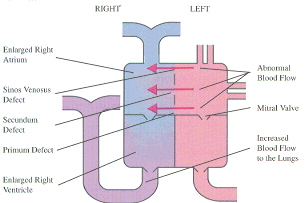
| Atrial Septal Defect (ASD) |
|
|
Down's Heart Group P.O. Box 4260 Dunstable, Beds, LU6 2ZT, United Kingdom Tel. & Fax: 0845 166 8061 E-mail: info@dhg.org.uk On-line community: http://groups.yahoo.com/group/Downs-Heart/ |
Reprinted with the permission of Penny Green, Director © 1998 Down's Heart Group UK Charity Nº 1011413 |

Diagram shows the heart looking from the front of the patient
There are three types of Atrial Septal Defect, the most common is where the hole is in the middle of the atrial septum called the secundum defect. Holes in the lower part of the septum, called the primum defect, are often associated with an abnormality of the Mitral valve (resulting in a leak). Less common are holes in the top of the septum which are associated with abnormality of the right upper lung vein, called the sinus venosus defect.
The amount of blood flow from the left to right atria is dependent on the size of the hole and on the pressure difference between the atria. The higher the rate of flow, the more strain that is placed on the heart.
Symptoms
Generally children with an ASD defect will exhibit no symptoms (they are
asymptomatic) and the problem is only found when a routine clinical
examination detects a heart murmur. Occasionally a child will exhibit poor
weight gain and a failure to thrive, and if there is Mitral valve leakage
there may be early symptoms of breathlessness.
Treatment
Small holes which allow little blood flow from left to right generally cause
no problems, and if they are located in the middle portion of the septum, the
secundum defect, they may even close on their own (spontaneous closure).
However, moderate and large holes do not close, and the extra work over the years places a strain on the right side of the heart causing an enlargement of both the receiving and pumping chambers (atria and ventricle), and the results of surgical repair are not good in older children.
It is therefore, usual for surgery to be recommended in the first few years of life for larger holes, before excessive strain has been placed on the heart.
Holes at the bottom (primum defects) and large holes in the middle (secundum defects) will require surgical patching, but small holes with good margins (sufficient surrounding tissue) may be closed using an umbrella device (occluder) which is placed in position by way of a catheter, thus removing the need for open heart surgery.
Any abnormality of the Mitral Valve will usually be repaired at the same time as the atrial septal defect is closed.
Follow Up Advice
All patients with a cardiac defect, whether repaired or not, will require
antibiotic cover during any dental treatment to prevent any bacteria entering
the blood stream from where they can reach the heart causing bacterial
endocarditis (infection of the heart lining), which can be very serious.
If there was repair of the valve, it may have a residual leak which will require monitoring in case further surgery or valve replacement is needed. However, many children cope very well with leaky valves and do not need further surgery.
"Our daughter has recently had an operation for Primum ASD with Pulmonary Hypertension. She was only in hospital for one week, everybody said how well she got over the operation. Although she didn't seem well enough to come home, as soon as she did she got stronger and happier every day, and she is now like a new little girl. Before her operation she was always tired and clammy, but now she's up at 6 a.m. and goes to bed at 7 p.m."